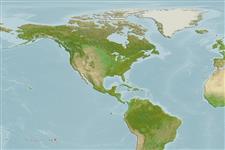>
Blenniiformes (Blennies) >
Blenniidae (Combtooth blennies) > Salariinae
Etymology: Praealticus: Latin, prae = in front of + Latin, altus, alticus = nutritious.
More on author: Seale.
Environment: milieu / climate zone / depth range / distribution range
Ecologia
marinhas. Tropical; 21°S - 24°S, 176°W - 128°W
Western Central Pacific. Eastern Central Pacific: Pitcairn (Ref. 41650) and French Polynesia (Ref. 46206).
Tamanho / Peso / Idade
Maturity: Lm ? range ? - ? cm
Max length : 7.9 cm SL macho/indeterminado; (Ref. 54980)
Descrição suscinta
Chaves de identificação | Morfologia | Morfometria
Espinhos dorsais (total) : 13; Raios dorsais (total) : 17 - 20; Espinhos anais: 2; Raios anais : 19 - 22. Lip margins smooth; females dorsally whitish to light gray and ventrally white with a series of 6 paired black spots (anterior 2 pairs irregular with a row of spots above) on upper side of body, and 1 spot on caudal peduncle, each connected by a gray bar to a lower series; a black line on back at spinous portion of dorsal fin, and 4 pairs of small black spots along base of soft portion; small bluish white spots on posterior half of body, mostly on upper half; narrow black bars ventrally on head angling on to throat; a white line at posterior edge of eye continuing below to upper lip; median fins with blackish margins; posterior part of crest with a narrow pink margin and a broad, submarginal black band; dorsal-fin base with alternating black and whitish blotches; a black spot at midbase of caudal fin; males similar except with darker body; bluish white spots on body generally elliptical; faint oblique black bands on throat; oblique white lines in soft portion of dorsal fin. Last spine of dorsal fin very small; dorsal soft rays usually 19; anal soft ray rarely 19 or 22; middle 6-9 of 14 segmented caudal rays branched; lateral-line pores 5-9 (Ref. 54980).
Facultative air-breathing (Ref. 126274); Adults are found in tidepools (Ref. 54980). Oviparous. Eggs are demersal and adhesive (Ref. 205), and are attached to the substrate via a filamentous, adhesive pad or pedestal (Ref. 94114). Larvae are planktonic, often found in shallow, coastal waters (Ref. 94114).
Ciclo de vida ou comportamento de acasalamento
Maturities | Reprodução | Spawnings | Egg(s) | Fecundities | Larvas
Oviparous, distinct pairing (Ref. 205).
Springer, V.G., 2001. Blennidae. Blennies (combtooth and sabertooth blennies). p. 3538-3546. In K.E. Carpenter and V. Niem (eds.) FAO species identification guide for fishery purposes. The living marine resources of the Western Central Pacific. Vol. 6. Bony fishes part 4 (Labridae to Latimeriidae), estuarine crocodiles. FAO, Rome. (Ref. 12848)
Status na Lista Vermelha da UICN (Ref. 130435)
Ameaça para os humanos
Harmless
Uso pelos humanos
Ferramentas
Relatórios especiais
Baixar XML
Fontes da internet
Estimates based on models
Preferred temperature (Ref.
123201): 24.7 - 25.9, mean 25.6 °C (based on 21 cells).
Índice de diversidade filogenética (Ref.
82804): PD
50 = 0.5001 [Uniqueness, from 0.5 = low to 2.0 = high].
Bayesian length-weight: a=0.00741 (0.00335 - 0.01640), b=3.02 (2.83 - 3.21), in cm total length, based on LWR estimates for this (Sub)family-body shape (Ref.
93245).
Nível Trófico (Ref.
69278): 2.0 ±0.00 se; based on food items.
Resiliência (Ref.
120179): Elevada, tempo mínimo de duplicação da população menor que 15 meses (Preliminary K or Fecundity.).
Fishing Vulnerability (Ref.
59153): Low vulnerability (10 of 100).
